This Post May Contain Affiliate Links. Please Read Our Disclosure Policy.
When you’re wanting a super juicy, tender chicken breast, this sous vide method just can’t be beat. Sous vide is an easy, foolproof slow-cooking method that gives you perfectly moist boneless, skinless chicken breasts every time. Seasoned any way you like, this recipe for never-tough, never-dry chicken will be your go-to for holidays, large gatherings, or any time at all.
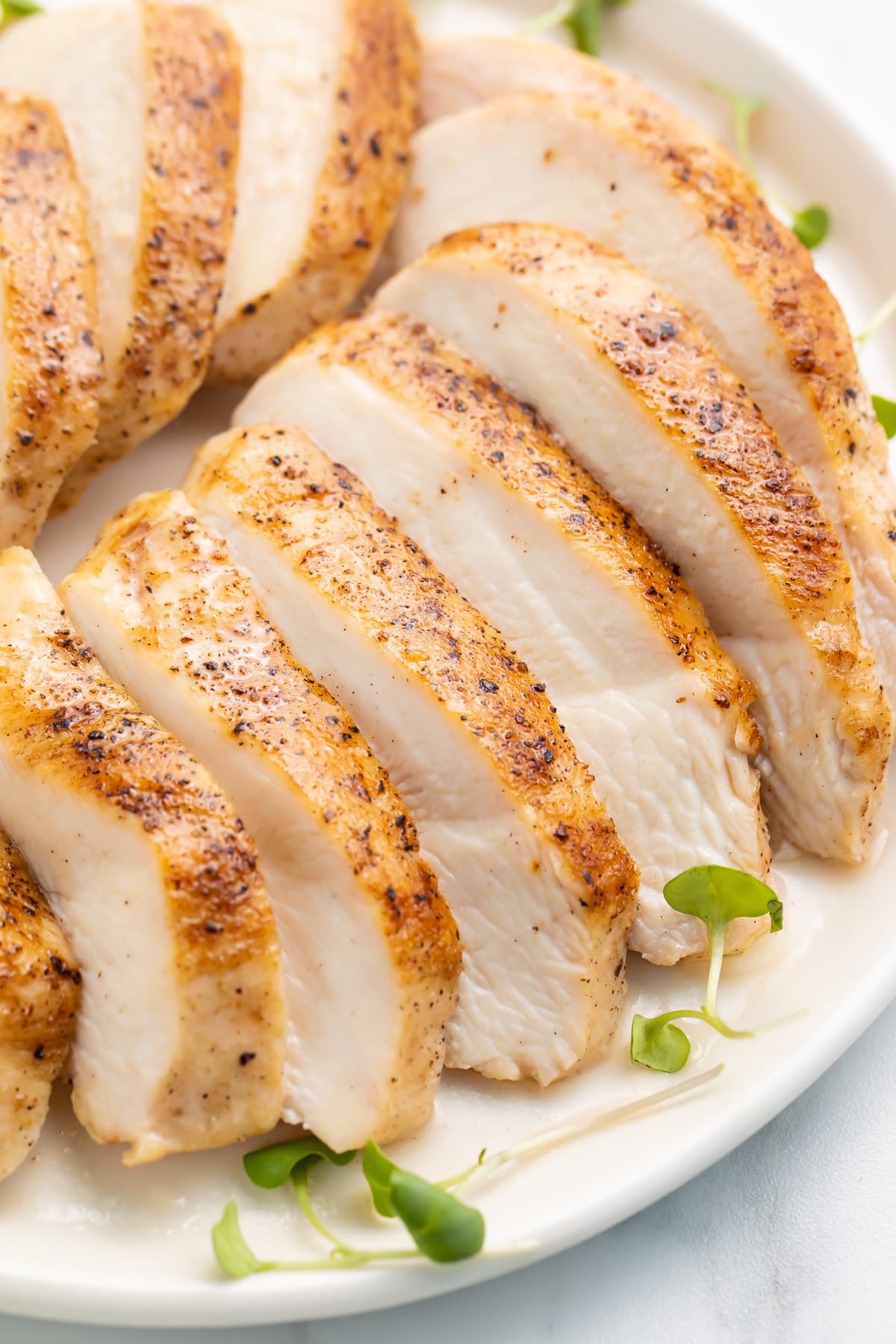
What is “Sous Vide”?
Sous vide, meaning “under vacuum” in French, is a method where food is precision-cooked in a vacuum-sealed pouch that’s submerged in a heat-regulated water bath.
The water bath keeps the food (in this case, chicken breasts) at a consistent temperature for longer periods of time than other cooking methods. This ensures the food is cooked evenly all the way through to the center, without the risk of overcooking the outer edges at the same time.
Before You Get Started
- It’s absolutely crucial that the chicken breasts are fully submerged in the water bath for the entire cook time. If they’re not completely submerged, they won’t cook evenly, so you might end up with undercooked sections or spots that are tough or dry.
How to Make This Recipe
See recipe card below for full list of measurements, ingredients, and instructions.
Prep the chicken.
Season 2 chicken breasts however you’d like, then put them in a large sealable food bag. Remove all the air from the bag, ideally with a vacuum sealer, and seal the bag completely. Place the bag of chicken in the preheated sous vide water bath and make sure the chicken breasts are totally underwater.
Cheryl’s Tip: If your chicken breasts just will NOT stay underwater, you can weigh them down by adding pie weights to the bag, taping silverware to the outside of the bag, or by using sous vide weights specifically for this purpose.
Enjoy your hour.
The sous vide’s got it from here! Let the chicken breasts cook in the water bath for an hour.
Sear the chicken.
After the chicken’s cooked for an hour, melt butter in a large skillet over medium-high heat. Take the cooked chicken breasts out of the water bath and bag, then pat them dry with paper towels and place them in the hot skillet. Sear the chicken breasts on both sides until they’re browned, then serve them however you like!
Cheryl’s Tip: If you plan to use the chicken breasts in another recipe, like a shredded chicken salad or chicken tacos, you don’t have to sear them after sous viding them. If you’re serving the chicken as-is, though, with just a side or two, I definitely recommend searing it first. There’s no browning or caramelization (a.k.a. the Maillard reaction) with the sous vide process.
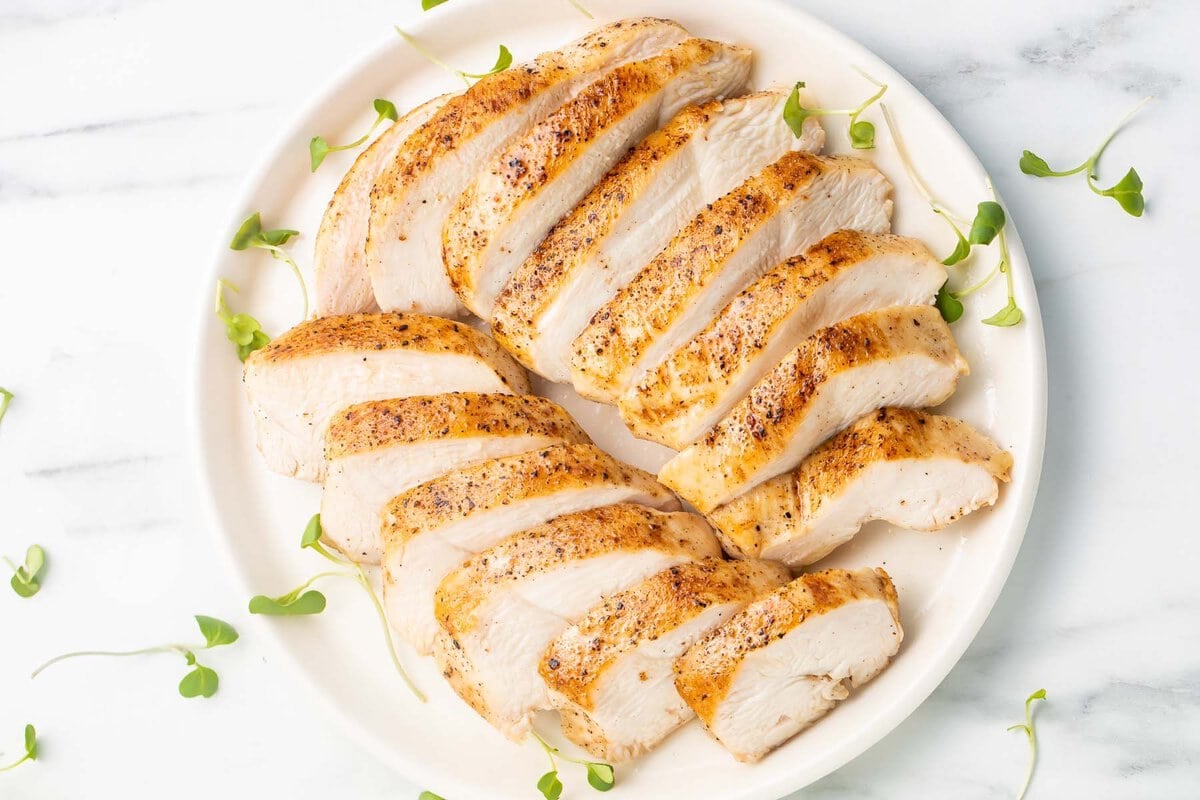
What I Love About This Recipe
- I. Love. Sous vide cooking. The method is just so easy – and SO foolproof. Drop the food in a water bath, come back later to perfectly cooked proteins or sides. It’s pretty much impossible to mess up. It’s also pretty much impossible to overcook the chicken breast this way, which can’t always be said for other methods.
- Another really great thing about a sous vide chicken breast recipe is that it’s super versatile. I used a simple salt-and-pepper seasoning with olive oil, garlic, and an infusion of fresh herbs, but you can season your chicken literally any way you like it. BBQ, garlic herb butter, lemon pepper, Cajun seasoning… anything goes!
- The sous vide method works for a frozen chicken breast, too. Trust me, you’ll be thrilled to have this option when you suddenly realize you forgot to defrost the chicken for dinner tonight. Just follow the recipe instructions as they’re written below, but add at least 30 minutes to the initial cook time. That gives the chicken extra time to thaw and then cook completely.
Is Chicken Cooked at 146.5°F Safe to Eat?
Yes! While the general food-safe temperature for chicken breast is 165° Fahrenheit, that’s actually an oversimplified standard.
What really matters is that pasteurization occurs, killing the salmonella bacteria – and that process depends on both temperature AND time.
165°F is the general guideline because at that temperature, pasteurization occurs instantly. Hit that number and boom, no more salmonella.
At 145°F, pasteurization takes around 9-10 minutes. That means the chicken has to reach 145°F all the way through and then be kept at that temperature for about 10 minutes.
It takes a little while for the chicken breasts to reach 145°F, though, which is why this recipe has a minimum 1-hour cook time.
Recipe Variations
- Chimichurri Chicken: Instead of fresh herbs, use the chimichurri sauce from our sous vide flank steak recipe.
- Garlic Lemon Chicken: Before adding it to the bag, rub the chicken with generous amounts of this simple lemon pepper butter or this incredible garlic herb butter.
- Cajun Chicken: Try a store-bought Cajun seasoning, or make your own with a blend of paprika, salt, cayenne pepper, cumin, dried thyme, pepper, and onion powder. For exact measurements, see our blackened shrimp recipe.
- BBQ Chicken: Give the chicken a little BBQ flair with your favorite store-bought dry rub. For a homemade version, use a mix of brown sugar, garlic powder, salt, smoked paprika, onion powder, chili powder, and black pepper. See our smoked chicken legs recipe for exact measurements.
- Mexican Chicken: Start with this easy taco seasoning, then turn your sous vide chicken into shredded chicken tacos.
- Make it Whole30/Paleo: Use ghee, avocado oil, or refined coconut oil instead of butter.
Making changes to a recipe can result in recipe failure. Any substitutions or variations listed are simple changes that I believe will work in this recipe, but results are not guaranteed.
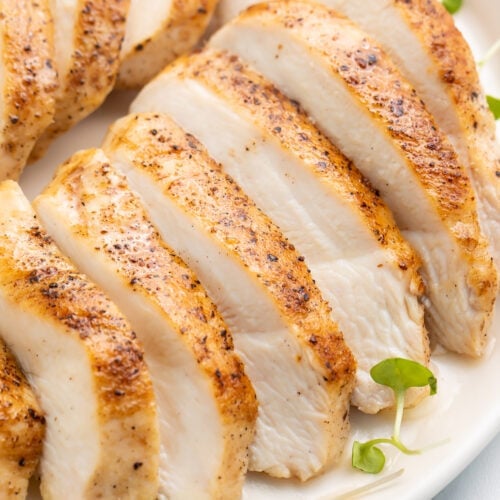
Sous Vide Chicken Breasts
Equipment
- Large pot or other large, heat-resistant container
- Sous vide immersion circulator
- Cutting board or large plate
- Basting Brush optional
- large food-safe vacuum sealing bag or large sealable food-safe plastic bag
- vacuum sealer optional, see Notes for alternative
- Large skillet
- Tongs
- Large plate
- Paper towels
Ingredients
- 2 medium boneless, skinless chicken breasts approximately 6 ounces each
- 2 teaspoons olive oil or other neutral-flavored oil
- salt to taste
- freshly cracked black pepper to taste
- 2-4 sprigs fresh herb(s) of choice thyme, rosemary, dill, etc.
- 1-2 cloves garlic peeled, smashed
- 2 tablespoons unsalted butter or ghee, avocado oil, or refined coconut oil
Instructions
- Fill large pot or other large, heat-resistant container with water. Insert sous vide immersion circulator and set temperature to 146.5° Fahrenheit. Note: pot must be deep enough that water level falls between minimum and maximum indicators on circulator.
- Place 2 medium boneless, skinless chicken breasts on cutting board. Brush or rub 2 teaspoons olive oil evenly over all sides of chicken breasts, then liberally season chicken with salt and freshly cracked black pepper on all sides.
- Place chicken in large sealable food-safe bag. Add 2-4 sprigs fresh herb(s) of choice and 1-2 cloves garlic, then remove as much air as possible from bag using vacuum sealer or water displacement method (see Notes). Seal bag completely.
- Once water bath is preheated to 146.5° Fahrenheit, place sealed bag in water bath. Make sure chicken breasts are fully submerged in water. If needed, use sous vide weights, silverware, or pie weights to keep chicken completely submerged.
- Cook chicken breasts 1 hour. Toward end of 1-hour cook time, heat skillet over medium-high heat. When pan is warm, add 2 tablespoons unsalted butter. Swirl and tilt pan to distribute butter across surface, letting butter melt completely.
- While butter melts, remove bag from water bath. Transfer chicken breasts to large plate and pat chicken completely dry on all sides with paper towels.
- Once butter begins to foam, place chicken breasts in skillet. Sear chicken 1 minute, then flip chicken over and sear 1 additional minute or until chicken is browned on both sides.
- Plate seared chicken with desired sides and serve warm.
- The chicken absolutely MUST be fully submerged in order to cook properly. Weigh the bag down as needed to keep the chicken underwater the entire hour.
- Vacuum Sealer Alternative: If you don’t have a vacuum sealer, you can use the water displacement method to push the air out of the bag instead. Place the chicken breasts in an appropriately-sized sealable food-safe bag and seal the bag halfway across the top. Slowly lower the half-sealed bag into the heated water. The temperature difference outside the bag will force the air out of the bag – you should see the plastic cling to the meat. Once the food is entirely submerged and the air is all out, seal the bag completely and continue with the recipe.
Approximate Information for One Serving
Nutrition Disclaimers
Number of total servings shown is approximate. Actual number of servings will depend on your preferred portion sizes.
Nutritional values shown are general guidelines and reflect information for 1 serving using the ingredients listed, not including any optional ingredients. Actual macros may vary slightly depending on specific brands and types of ingredients used.
To determine the weight of one serving, prepare the recipe as instructed. Weigh the finished recipe, then divide the weight of the finished recipe (not including the weight of the container the food is in) by the desired number of servings. Result will be the weight of one serving.
Did You Make This Recipe?
Tag @40aprons on Instagram and be sure to leave a review on the blog post!
Frequently Asked Questions
I prefer to cook the chicken for just an hour, to keep things quick and easy. In a water bath kept at 146.5° Fahrenheit, though, chicken breasts can be cooked up to 4 hours before the texture is negatively affected.
Yes – as long as the chicken is cooked at that temperature for a minimum of one hour.
That typically means at least one of two things. Either your water bath temperature was too high, or you left the chicken in the water bath too long.
Other Easy & Delicious Recipes You’ll Love
Never Miss A Meal!
New Recipes Straight To Your Inbox
A curated selection of our most recent recipes, delivered straight to your inbox once a week.
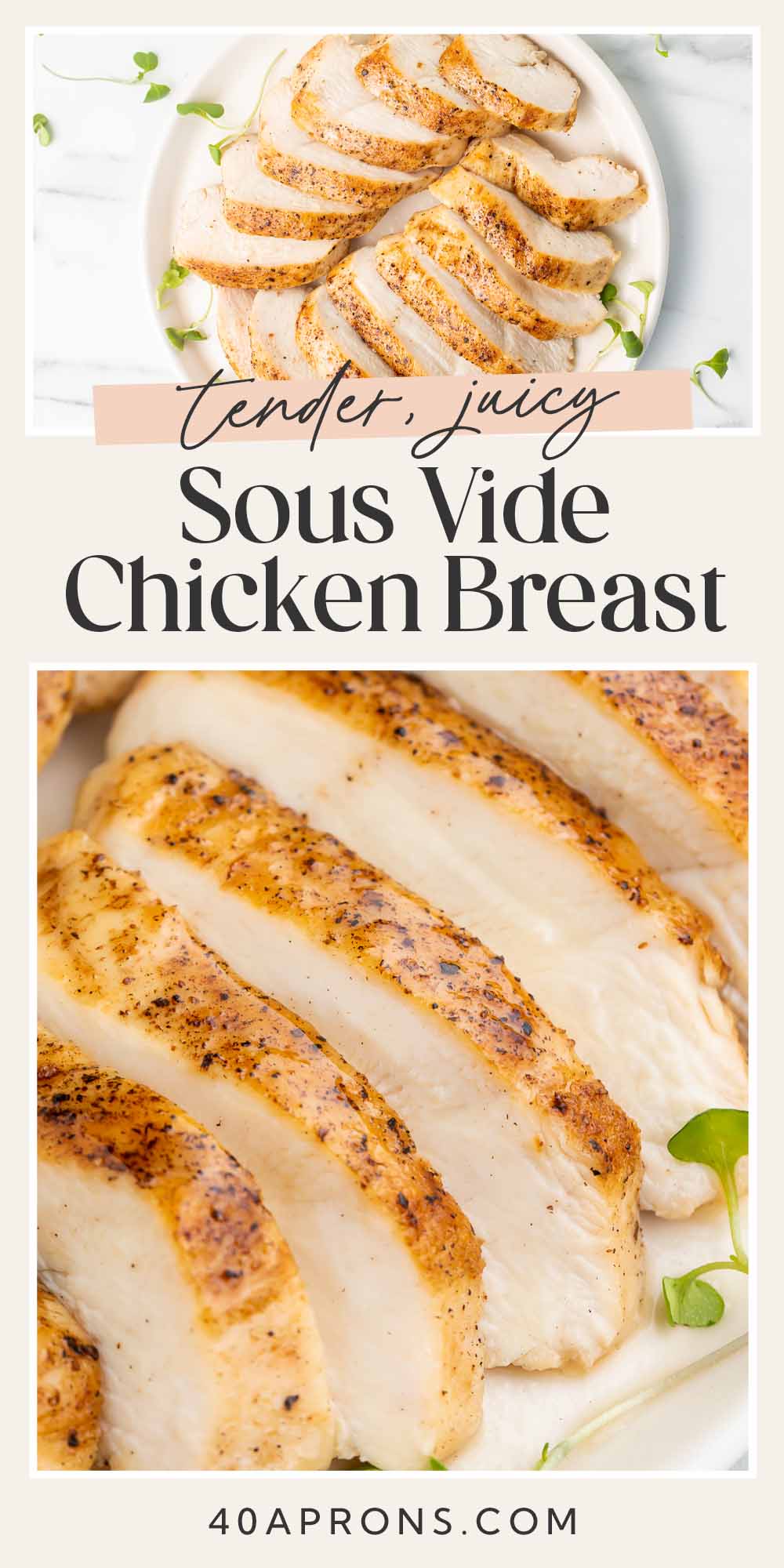
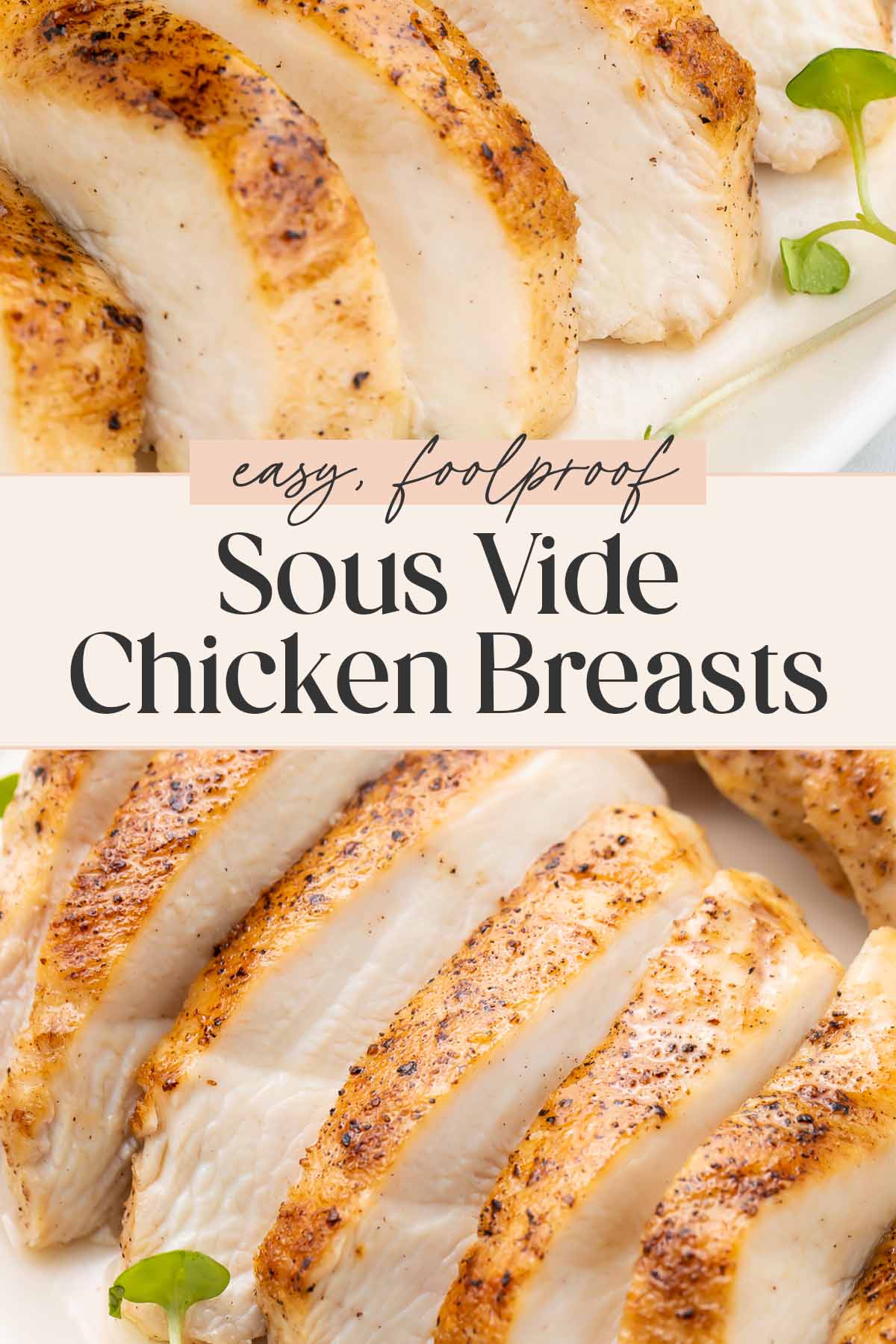
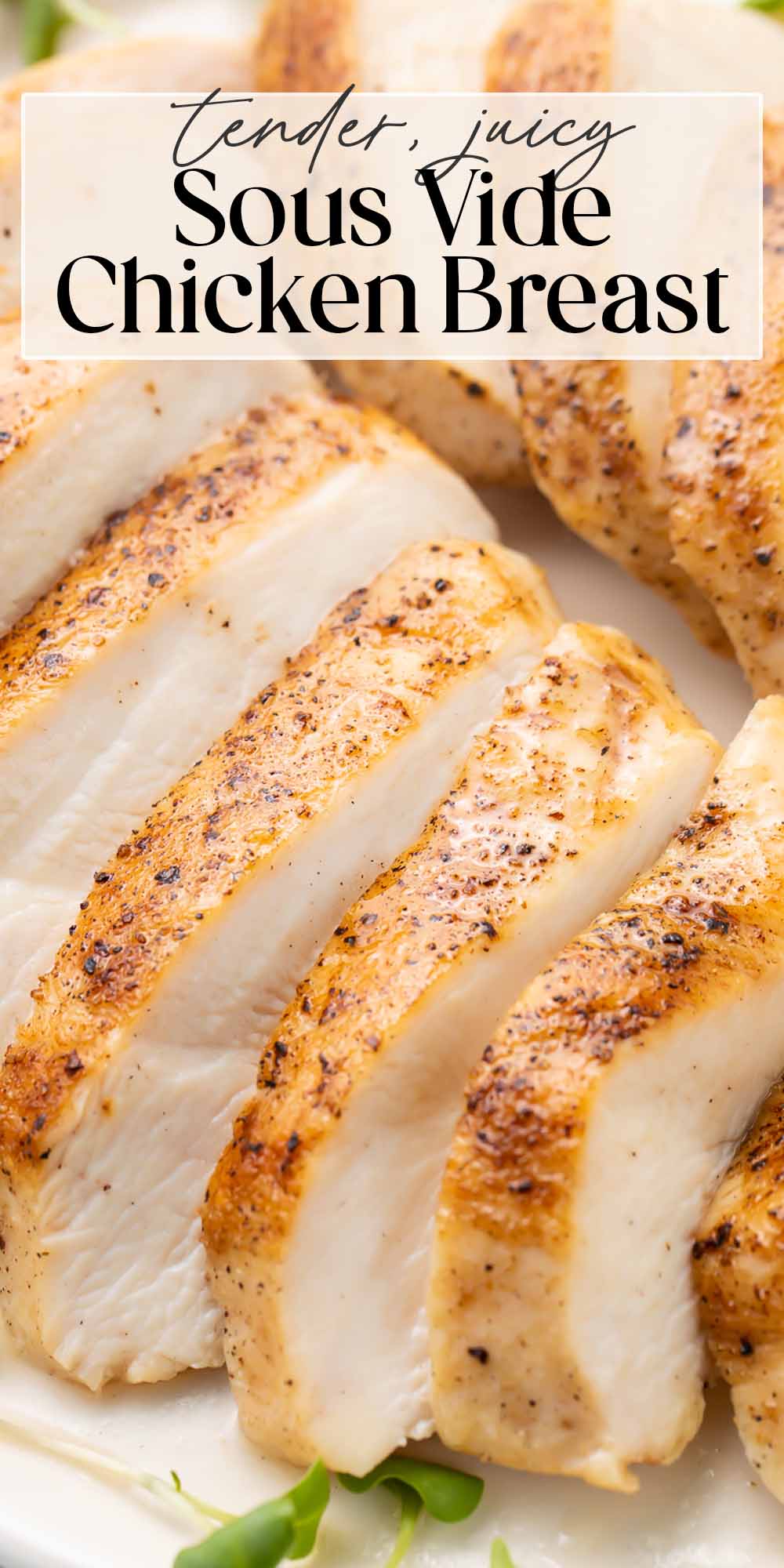
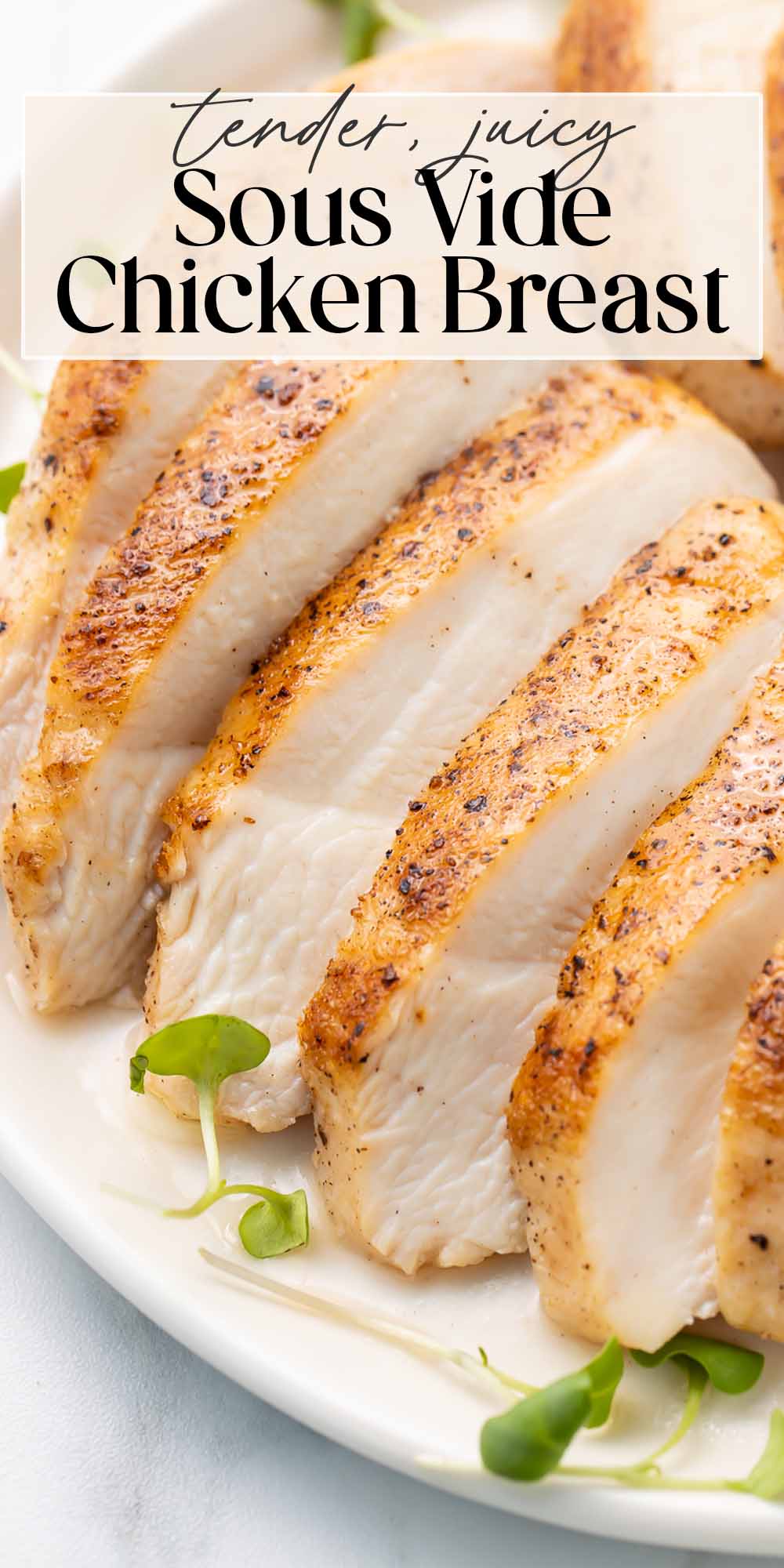
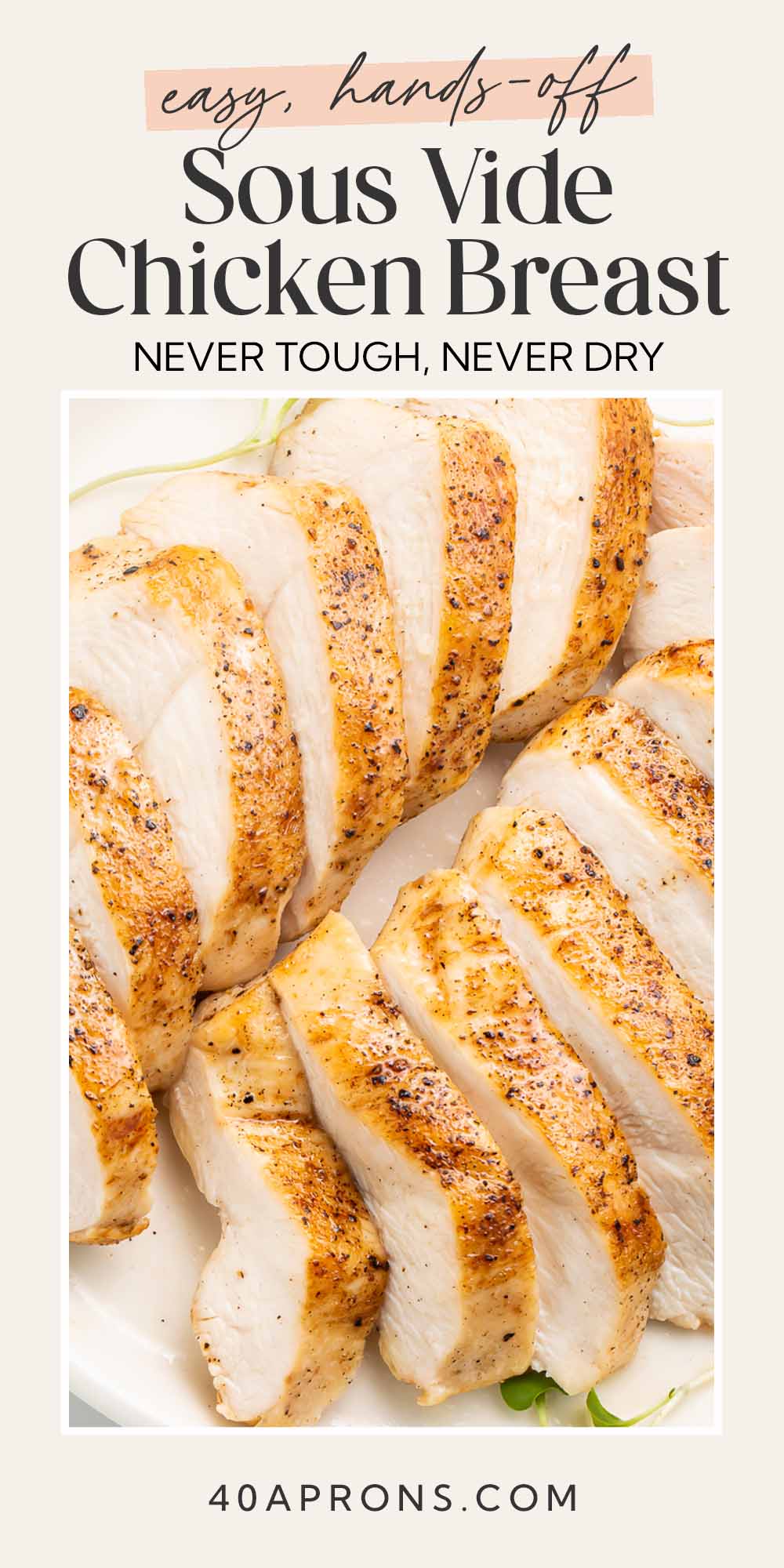
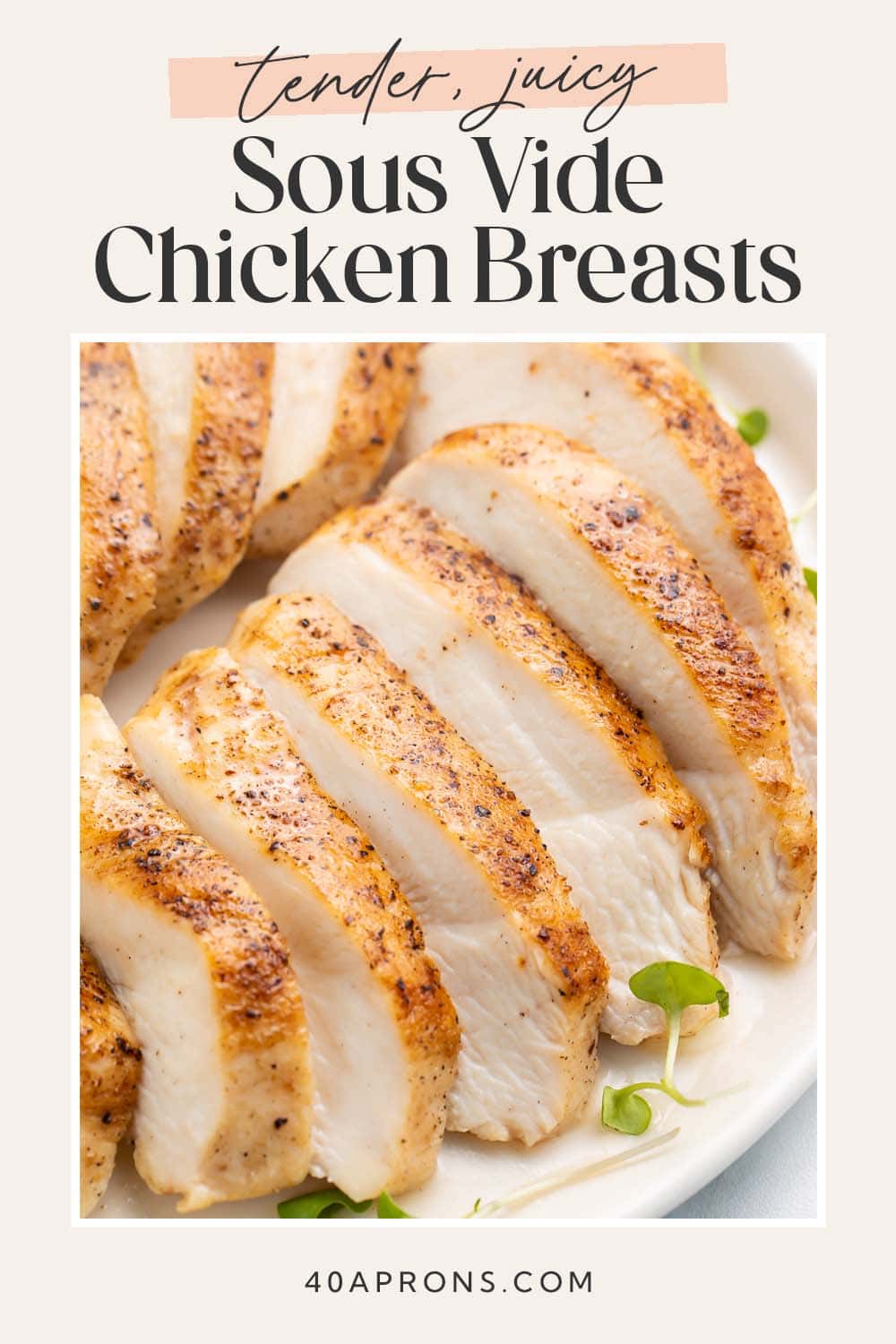
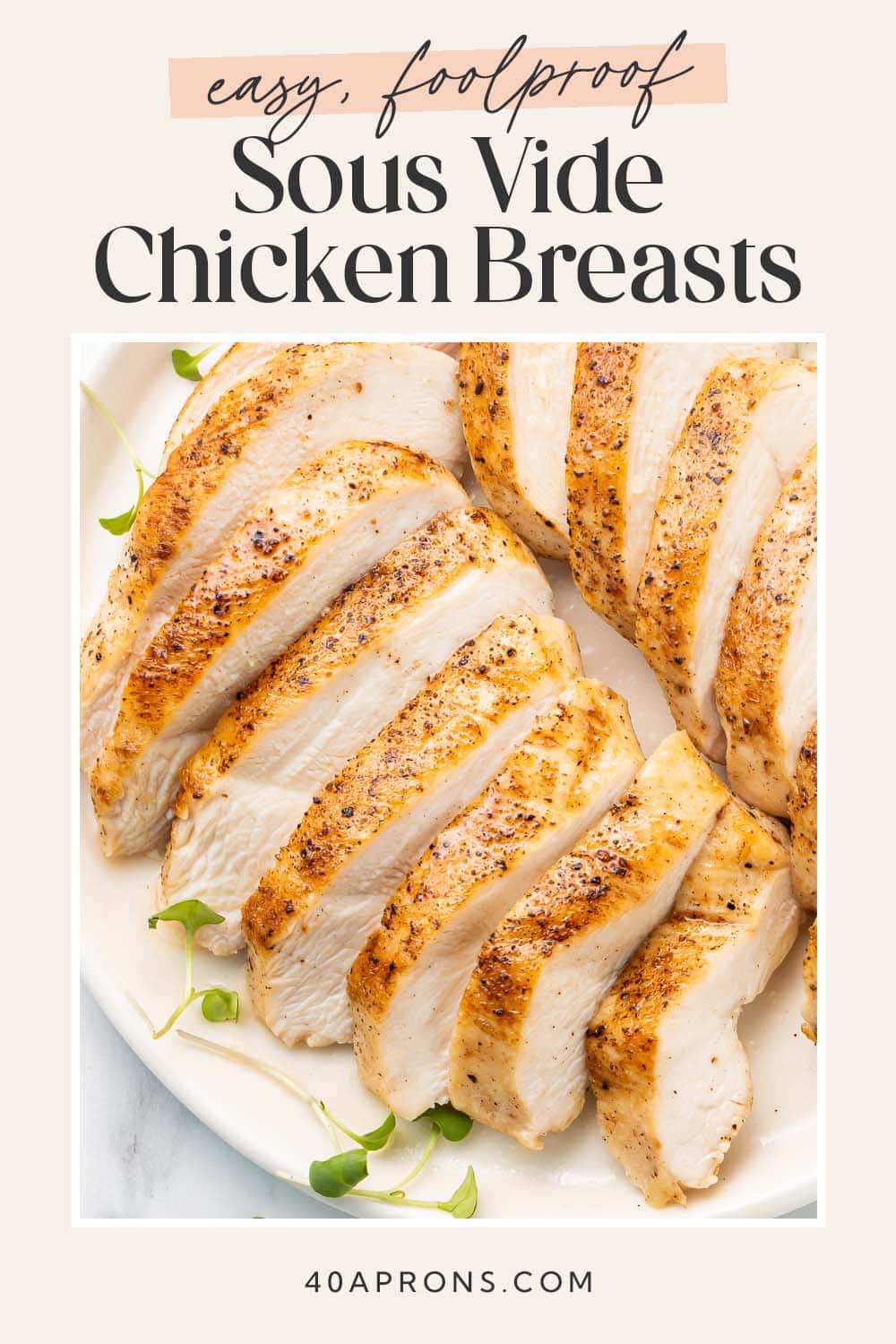
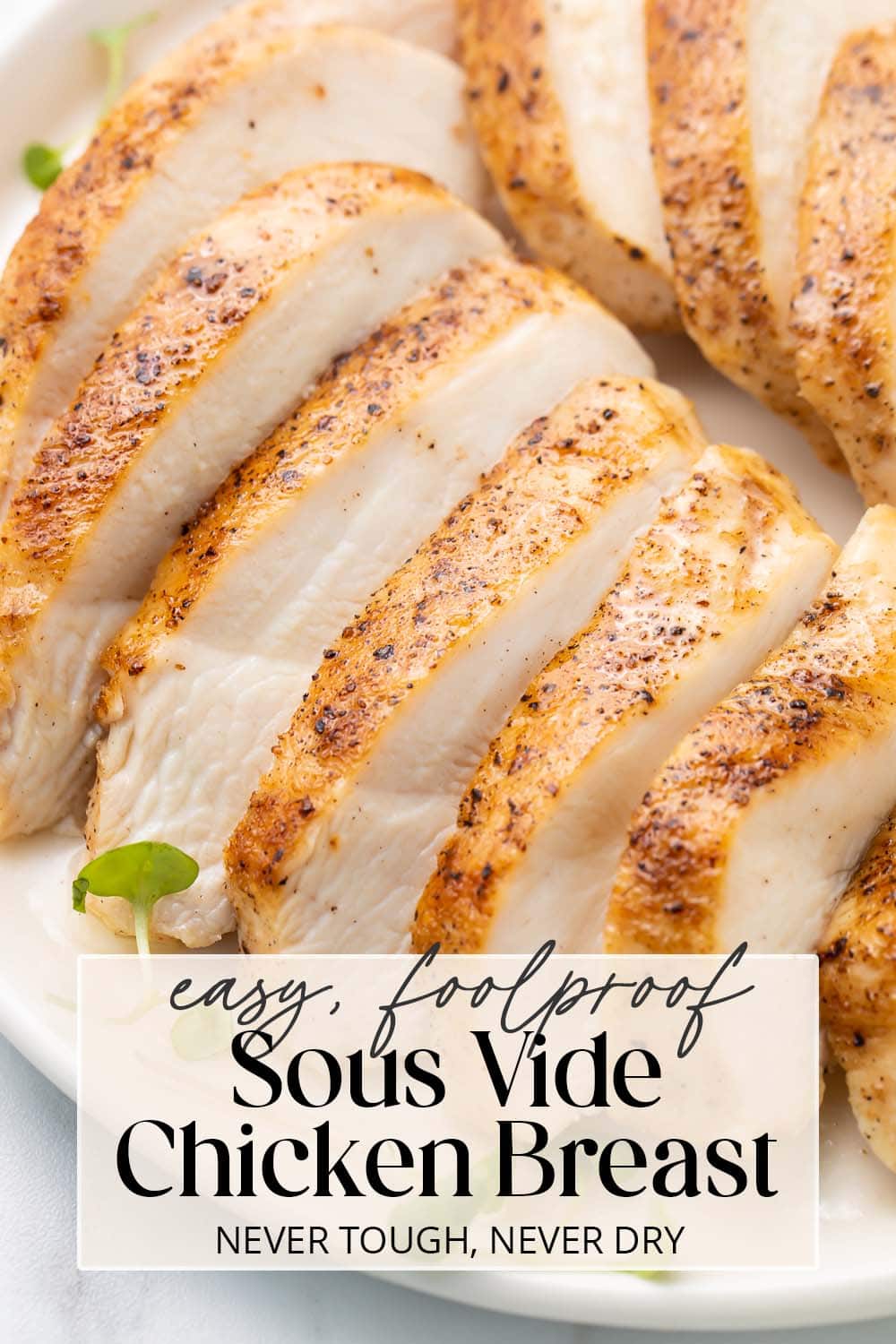
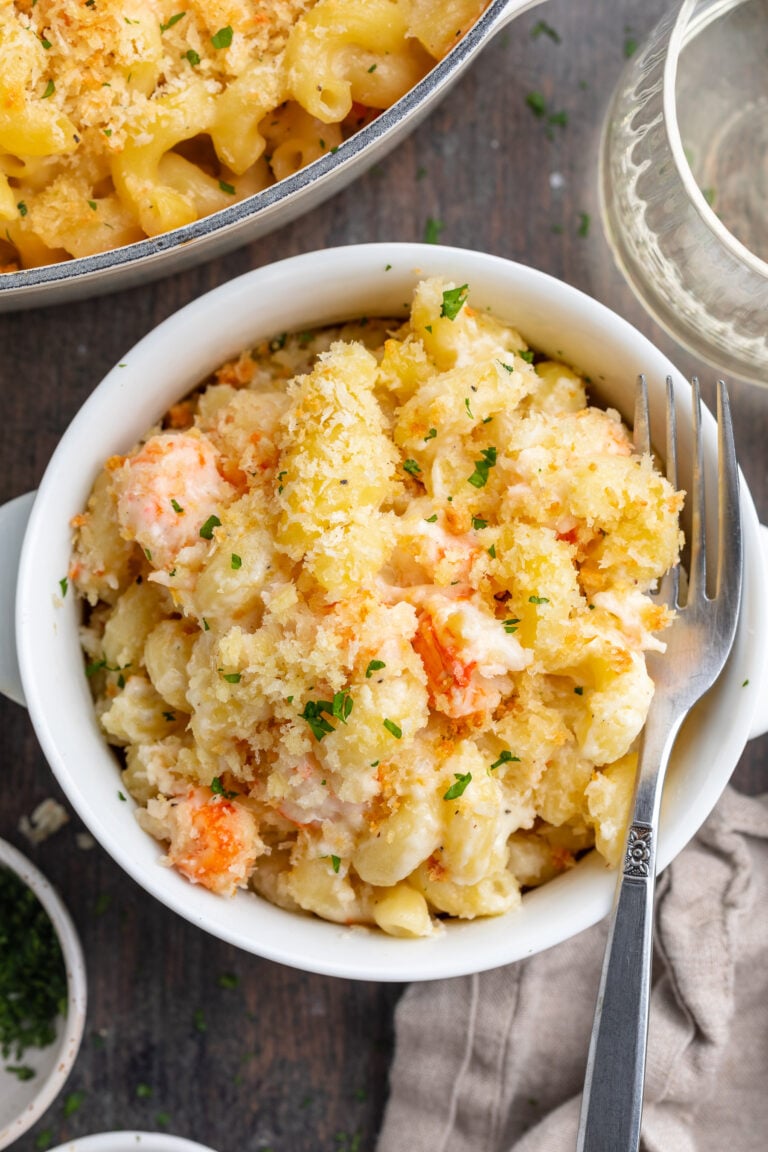
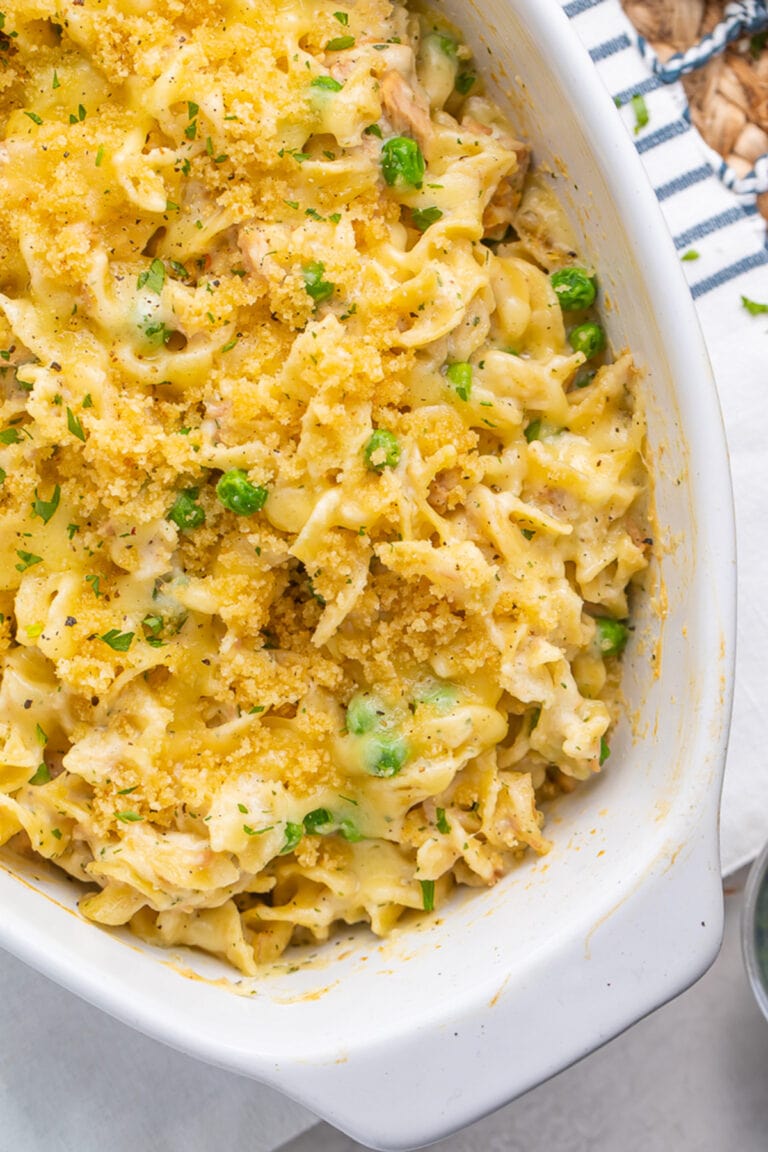
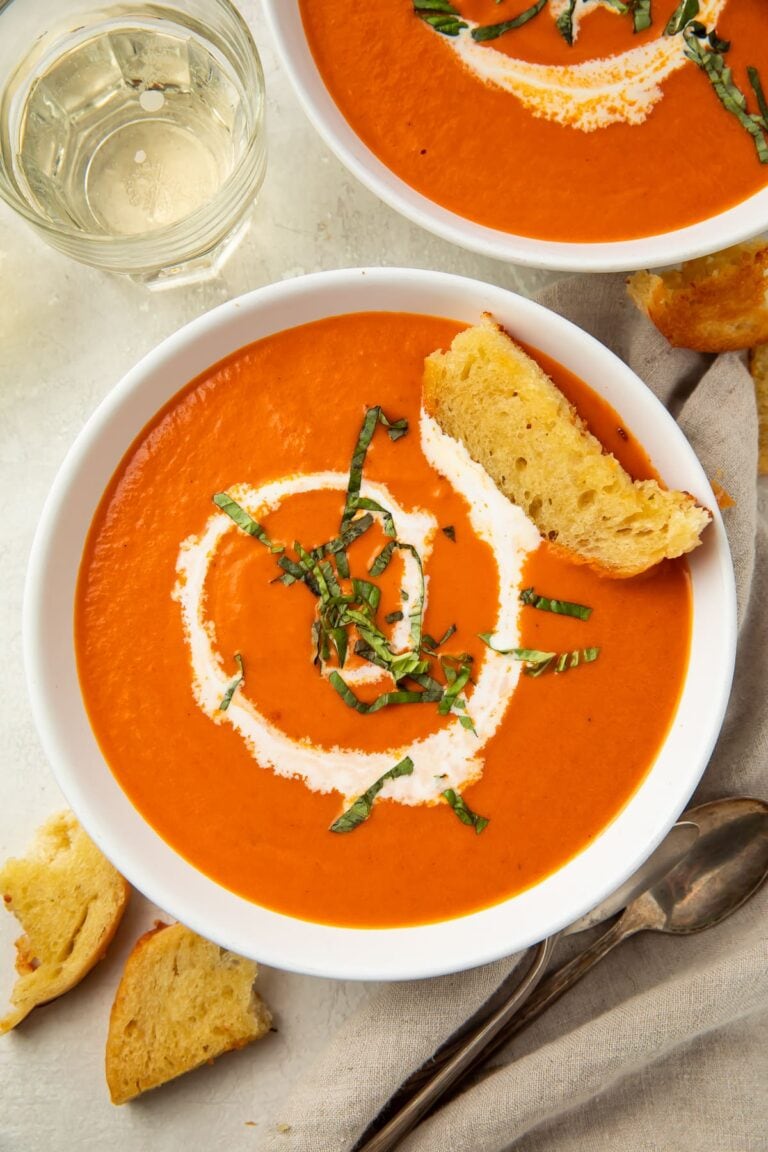
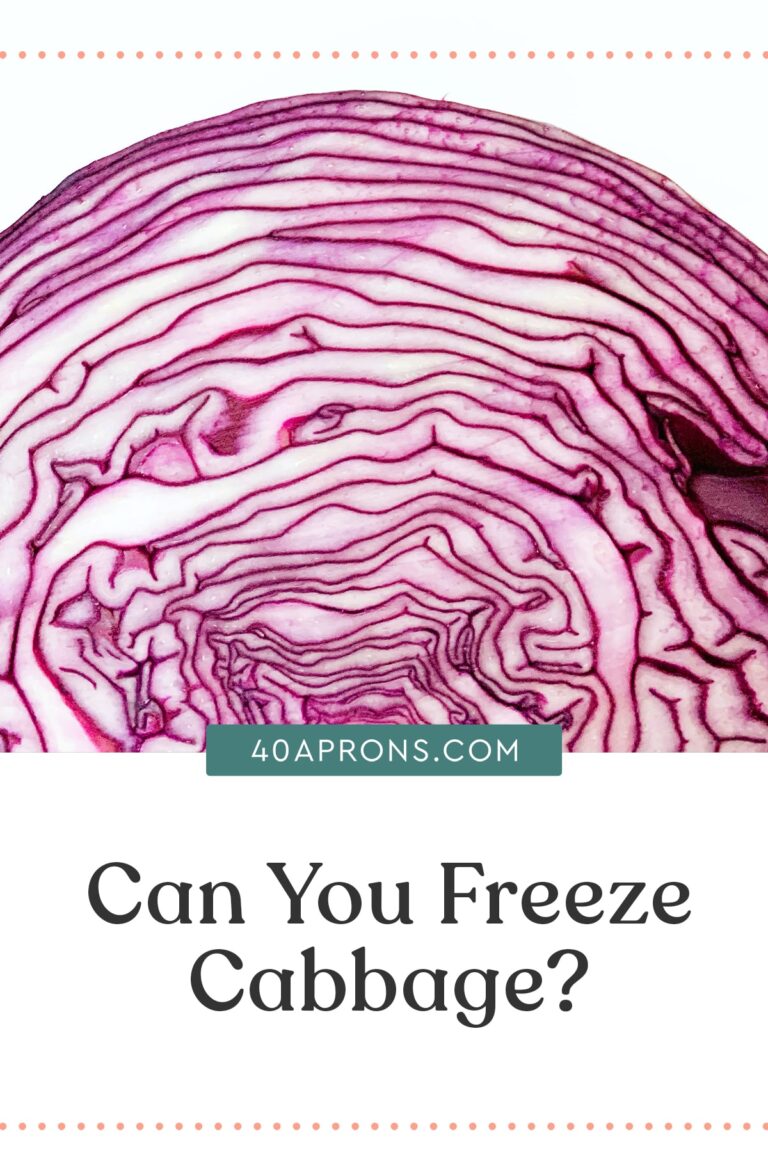
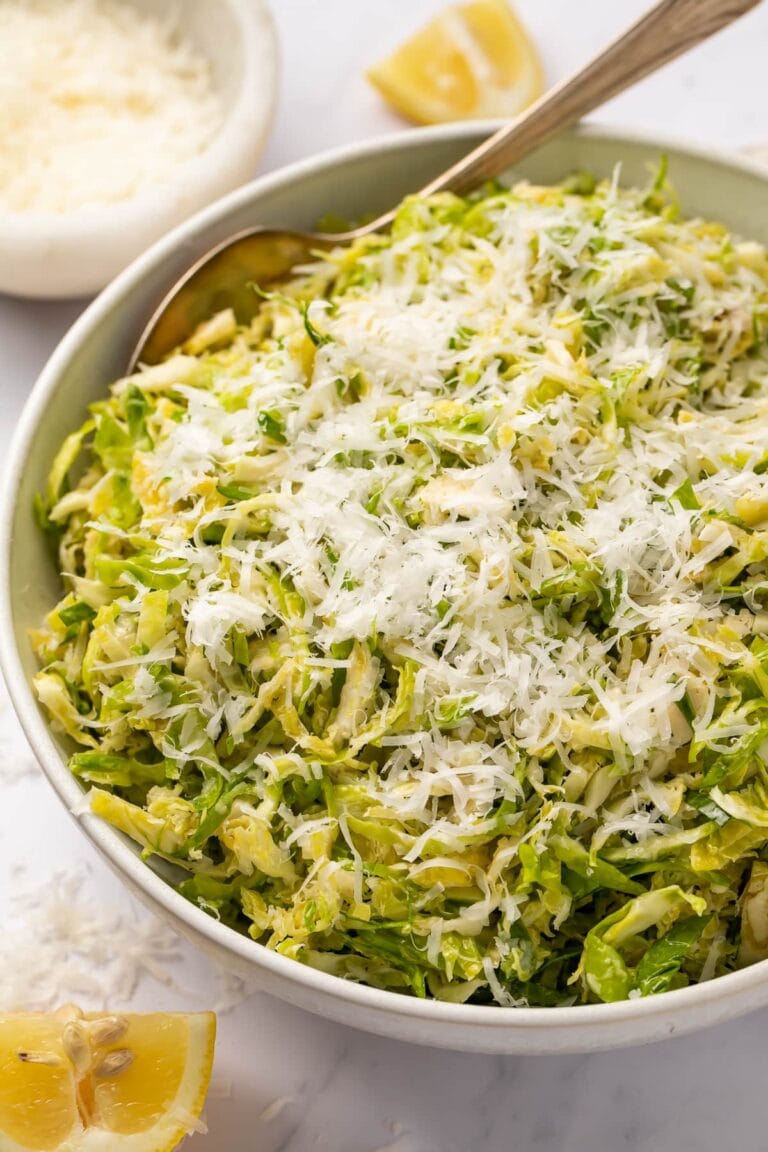










Perfection. I had been heating my bath to 155 or so, as I detest undercooked chx, but decided to try and this was soooo tender. Sold on 145. Not sure about the ice bath. I just allow to cool a bit naturally and sear in a hot pan after drying. I use reusable silicone bags and use 2 magnets on the side of my bin to keep submerged. Doing my part for environment.
So glad you enjoyed it! Thanks for sharing, Rob!
Great detail with various suggestions. Great recipe
So glad you enjoyed it! 😊
half the chicken was great and half was very tough and chewy.it was heritage chicken, going to try longer cook time next time.
Oh no! So sorry to hear this. Be sure to let us know if you try it again!
This was seriously amazing. I was hesitant to cook chicken using sous vide. I am a believer and will absolutely be cooking my chicken breasts with this recipe from now on. The texture is perfect to the point where it’s unbelievable. Thank you!!
I was skeptical about the sous vide too, at first! But it really does work magic on meat! So glad you enjoyed it, Heather. Thanks for sharing! 😊
Skeptical? Why? Now try doing London broil at 133°. I season copiously and add teriyaki to bag. O.M.G.! You would not believe it’s London broil. Incredibly tender. Some say to cook for 7 hours, but I can’t NOT eat after about 2. Temp seems to be key. Was doing at 128°. Pork? 145.
Can these be put in the fridge after the sous vide and then seared later when you are ready to eat them?
I cook POUNDS at a time and then freeze and let small amounts thaw in fridge as needed. Huge time saver. I make healthy stir fries at a fraction of a cost as frozen dinners.
When you cook ahead, do you bring chicken to room temp before searing to ensure you don’t have cold bites? How long do you sear for when you use chicken that is coming out of the fridge?
Always cook the chicken fully before cooling it and storing it for later! Partially cooked chicken can’t be safely stored and finished later. You can reheat the fully-cooked chicken after refrigerating or freezing it.
Easy to make and tasted excellent.
So glad you enjoyed it! 🙂
You were not kidding, or exaggerating… This is easily the—if not one of the—best chicken breasts I’ve ever eaten!! And I didn’t buy any fancy boneless chicken breasts; I went to Costco and picked up the Kirkland brand. I pan fried a couple of them initially and just tolerated them. They were dry and flavorless. Your sous vide recipe turned them into something out of a four- or five-star restaurant. I even left one half of a breast on a plate for about two hours, came back expecting it to be dry and hard, and even though it’s not warm, it’s still more tender than any other chicken breast I can recall eating in many many years. You have gotten me excited about chicken again, and I continue to be a fervent supporter of sous vide. Thank you so, so much! By the way, I am easily one of the pickiest eaters in existence.
WOW, what a review!! Thank you SO much, EV – I’m thrilled you enjoyed this chicken recipe so much!
This! Was me until I found sous vide. The only thing that doesn’t get stuck in my water bath or my chicken thighs that I do on my grill! Be sure to try London broil at 133° for about two hours at least, that is if you like beef. Takes lean, chewy cut it makes it fork cut tender.